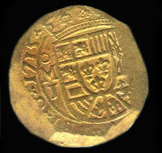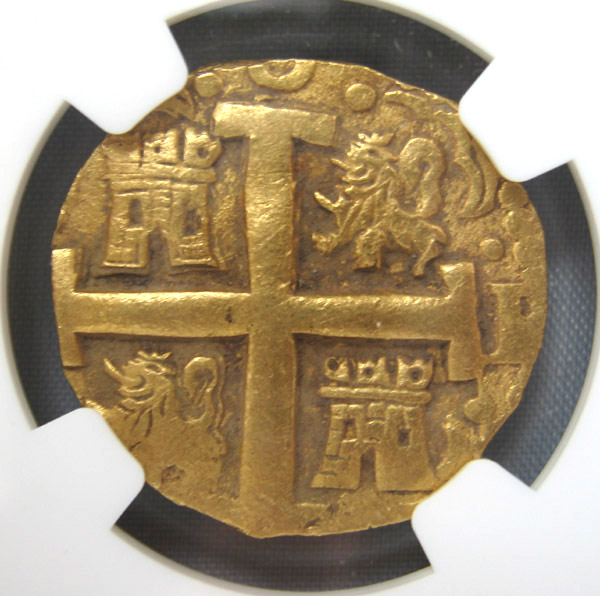 |
|
|
|
|
||
|
Fernando VI, the Spanish monarch who ended the cob coinage at Lima. His ordinal (VI) is visible at 7 o'clock on the cross side of our coin. |
The Last Gold Cobs from the Lima Mint
L62. Peru, LIMA 1750 R four escudos. Struck with an 8 escudos cross die. A beautifully struck and centered, heavily coraled, mint state media onza recovered from the wreck of Nuestra Senora de la Luz (1752). An exceptionally well struck 4 escudos pillar side is muled with a very bold 8 escudos cross. SOLD.
Before the discovery of "Our Lady of Light" in 1993, the 1750 Lima four escudos was not known to exist. The recovery from the La Luz proved a 1750 four escudos mintage occurred, but revealed that something totally unexpected and unprecedented had happened in the last days of Lima's gold cob coinage. It is now clear that the largest issue ever of four escudos from the Lima mint (1696-1750) occurred in 1750, and in fact mostly in the last month (December) of 1750, and in a completely unplanned fashion.
No explanation of this remarkable mintage is yet forthcoming. All we know is that such an exceptional mintage of four escudos never occurred before or after 1750 at the Lima mint. The four escudos was always the rarest denomination at Lima, both for cobs and the milled portrait issues that began in 1751. For the entire post-Fleet era, 1715-1749, only 4 or 5 Lima four escudos are known, reflecting no mintage at all in most years or only a very exiguous mintage that has vanished. Portrait Lima four escudos are almost as rare for years after 1750. All Lima four escudos are rare coins! But here is what we do know about the remarkable mintage of 1750.
The Uruguayan salvors of La Luz found fifty 1750 Lima four escudos. They auctioned most of these coins in a 1993 New York Sotheby's sale. Our coin was lot 548 and realized $6350 nineteen years ago. The salvors of the La Luz were numismatists and quickly noticed something strange about the 1750 fours. First of all, there were seven different cross dies in use (one or two would be normal). Secondly, five of the seven dies were not four escudos dies at all. They were 8 escudos or even 2 escudos dies. The vast majority of the 1750 four escudos mintage was not struck from four escudos dies! This was no mint error or mistake. Clearly the coiners at Lima in 1750 had encountered a problem: a large mintage was unexpectedly required (late in the year) and the two normal Lima cross dies were already exhausted. What to do? No new cob dies could be ordered because the cob coinage was now discontinued in favor of milled portrait issues. The coiners had to make do with whatever was on hand, so they carried on striking a substantial four escudos coinage with 8 and 2 escudos dies. Nothing like this had ever happened at Lima, or at any other Spanish Colonial mint for that matter. It was illegal, but necessity made its own law. (The same problem occurred to a lesser extent with the 1750 eight escudos mintage, where the coiners had to mule a worn, retired 1749 pillar die with a 1750 cross die to complete the onza mintage.)
The workmanship of the final Lima gold cob dies under assayer Rodriquez (R) never approaches the fine quality of the Hurtado's (H) or Megarejo's (M) Fleet-era coinage. Designs features like the lions and castles were often unusually crude in the last years of Lima and carelessly punched into the dies. That said, Rodriquez had clearly made some effort with the dies for the last year of cob coinage. This 1750 four is struck from a normal 4 escudos pillar die and an eight escudos cross die. Seven 1750 fours of this variety were found. See page 111 of the Sotheby's catalogue.
The December 1750 coinage using 8 escudos and 2 or 4 escudos dies almost always shows weak and worn features. The lions and castles in particular often lack any detail. . This coin is the best of that small (7) group. It is mint state and beautifully centered. A better specimen of this last gold cob from Lima will be very expensive.
It is my policy not to remove gold cobs from NGC or PCGS holders, however incomprehensible (AU 50) their grading call. Here I need to tell you that NGC will not grade this lovely 4 escudos as mint state until it is "conserved", that is to say, striped of its 250 year old Montevideo coral. See the notice above. In my opinion this is something that should never be done. Original La Luz gold cobs, especially the finest of them, should be left in their original as-found condition. "Conserving" pieces like this magnificent Luz 4 escudos would both reduce its appeal to advanced collectors and lower its value. If you are a collector who wants a conserved coin with bright cleaned surfaces, there are coins available. This beauty is not for you.
SOLD.
Terravitan@aol.com or 480-595-1293
|
|





